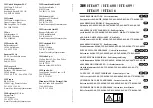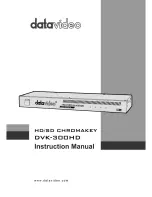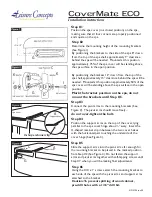
2
3
4
Congratulations on your purchase of an Ikelite Compact Video
Housing. Ikelite has over 45 years of experience in the underwater
photographic, video, and lighting market.
Our products are
designed and built in
the USA by Ikelite for
both the professional
and amateur.
The clear housing
permits instant visual
inspection of the
camcorder and all
sealing surfaces as
well as complete
monitoring of controls
and camcorder LCD
screens.
Ikelite Compact Video
Housings are neutrally
buoyant in salt water
for stability. This
housing has been
water pressure tested at the factory. All camera controls are fully
functional through the housing which is water pressure tested to
200' (60m).
Ikelite Compact Video Housing
i n s t r u c t i o n m a n u a l
#
#55665500..0011 JJVVCC PPiiccssiioo GGCC--FFM
M11 VViiddeeoo CCaam
meerraa
#
#55665500..0022 JJVVCC PPiiccssiioo GGCC--FFM
M11 VViiddeeoo PPaacckkaaggee
PPlleeaassee RReeaadd
We suggest that you read this instruction booklet thoroughly
before use. If you are new to underwater photography be sure
to read the General and Photo Tips.
We also suggest that you read the JVC Basic User Guide
thoroughly to have a full understanding of where each
camcorder control is located, and what function each control
provides.
CCaam
meerraa SSeettuupp
- Turn off the camcorder. Connect the camcorder to a computer
with the USB cable to fully charge the camcorder battery.
- Set the Date and Time (page 9 of your JVC Basic User Guide).
- To assure that your camcorder is operating properly, try
recording and playback modes before placing your camera in
the Ikelite Compact Video Housing.
H
Hoouussiinngg SSiizzee aanndd W
Weeiigghhtt::
5.5" wide x 4.25" high x 3.0" deep (including controls and lens port).
14cm x 11cm x 7.6cm.
Housing with camera weighs less than 1.25lb (0.56kg) above water.
Neutrally buoyant underwater.
O
Oppeenniinngg tthhee H
Hoouussiinngg
1. Place the housing face down in your lap or on a flat surface.
2. Depress opposing latch buttons simultaneously to open
housing. Once the latch is unlocked, rotate the latch handle up
and away from the housing until it stops. This motion will also
break the housing o-ring seal and open the housing back
slightly.
N
NO
OTTEE:: Latch must be rotated to the fully open position to assure
easy opening of the back. Rotate the hinged back to it’s open
position.
Top View
latch closed
Top View
latch opened
Latch
Button
PU
SH
T
O
UN
LO
CK
Latch
Button
Latch in open
position
O-ring
Housing Back - Side View
M
Maaiinn H
Hoouussiinngg O
O--rriinngg
Check to see that there is an o-ring on the housing back and
that it is clean, lightly lubed, and in its proper location.
O
O--rriinngg M
Maaiinntteennaannccee
We recommend that you clean the main housing o-ring and
o-ring channel before each day of diving.
1. To remove the o-ring, place your index finger and thumb on the
o-ring as shown (Figure A, Page #5).
2. Squeeze the o-ring into a loop by pressing down on the o-ring
and squeezing your index finger and thumb together (Figure B,
Page #5).
3. Grab the o-ring loop with your other hand and remove the
o-ring from the housing back.
4. Wipe the o-ring channel clean with a paper towel, napkin, or
lint-free wiping cloth .
5. Clean and lightly lube the o-ring. Use Ikelite lube only (supplied
with housing).
6. Very lightly lube the o-ring sealing surface on the housing front.
CCAAU
UTTIIO
ON
N:: Never use a screwdriver or metal object to remove the
main housing o-ring. This could damage the housing and o-ring,
which could result in a leak.






















